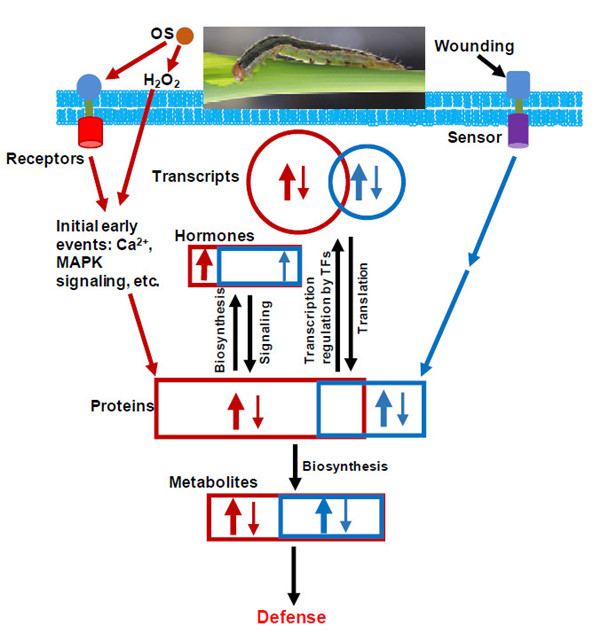Plant Cell Environ:中科院吴建强研究组等发表玉米抗虫响应研究成果
近日, 国际植物学领域《Plant Cell & Environment》期刊在线发表了中国科学院昆明植物研究所吴建强研究组与中国科学院大连化学物理研究所许国旺研究组、德国马普化学生态学研究所Ian T. Baldwin教授研究室合作的题为“Oral secretions from Mythimna separata insects specifically induce defense responses in maize as revealed by high-dimensional biological data”的研究结果。研究组在玉米抗虫响应研究获得进展。
玉米是我国乃至世界总产量最高的作物,在农业生产上占有重要地位,而每年由于虫害导致的产量损失约占玉米总产量的10%以上。在我国,粘虫(Mythimna separata Walker)是玉米生产面临的重要威胁之一。粘虫取食造不但成大量玉米减产,每年防治粘虫必须使用大量农药,造成了不可忽视的环境和生态问题。了解粘虫和玉米间如何相互作用对玉米自身诱导抗虫性和培育新型抗虫玉米、开发有效生物防控手段有重要意义。然而,玉米在受到粘虫取食后,如何通过启动基因转录、蛋白表达,以及合成和积累抗虫相关次生代谢产物,从而增强自身对粘虫的抗性,人们所知甚少。
研究人员深入分析了玉米受到机械损伤及模拟粘虫取食处理前后,转录组、蛋白质组、代谢组以及抗虫相关激素的变化。研究发现,玉米可以特异地识别粘虫口水中的某些诱导因子,并启动一系列强烈的抗性反应。与机械损伤相比,玉米在识别模拟粘虫取食后,能够诱导更多、更强烈的基因、蛋白和次生代谢产物的转录、翻译及合成。本研究还首次对玉米抗虫响应的转录组和蛋白质组进行了关联研究,发现它们之间存在较弱的关联。本研究发现近300个转录因子参与粘虫取食诱导的响应。通过大规模数据分析,该研究首次揭示了玉米在特异识别粘虫取食后,在转录、蛋白以及次生代谢产物层面,如何进行有效的抵御,为玉米品种改良及新品种培育,提供了大量的候选基因、蛋白和代谢物的基础数据。

图: 玉米对粘虫的特异抗性响应模式图
原文链接:
Oral secretions from Mythimna separata insects specifically induce defense responses in maize as revealed by high-dimensional BioLogical data
原文摘要:
Attack from insect herbivores poses a major threat to plant survival, and accordingly plants have evolved sophisticated defense systems. Maize is cultivated as a staple crop worldwide, and insect feeding causes large production losses. Despite its importance in agriculture, little is known about how maize reacts to insect herbivory. Taking advantage of advances in sequencing and mass spectrometry technology, we studied the response of maize to mechanical wounding and simulated Mythimna separata (a specialist insect) herbivory by applying its oral secretions (OS) to wounds. In comparison to the responses induced by mechanical wounding, OS elicited larger and longer-lasting changes in the maize transcriptome, proteome, metabolome, and phytohormones. Specifically, many genes, proteins, and metabolites were uniquely induced or repressed by OS. Nearly 290 transcription factor (TF) genes from 39 families were involved in OS-induced responses, and among these, more TF genes were specifically regulated by OS than by wounding. This study provides a large-scale omics dataset for understanding maize response to chewing insects, and highlights the essential role of OS in plant-insect interactions.
作者:吴建强

